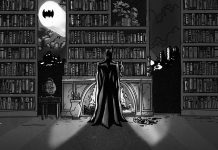EDITOR’S NOTE: The following Old School BOF article — “A Joker’s Dozen, Part 1 (of 12)” by Robert Reineke — was originally posted on BOF in May of 2007. – “Jett”
One of the touchstones of The Joker’s interpretation in comics is the first dozen stories featuring the Joker that follow his introduction as a cold blooded killer and his transformation into a clever prankster that would bedevil Batman over the years without falling prey to the morality police. There are a dozen stories that make up this initial introduction, so 11 parts to go after this.
 The Plot: The Joker steals gems and kills their owners following radio announcements.
The Plot: The Joker steals gems and kills their owners following radio announcements.
Body Count: Four (1 by delayed action poison, 1 by poison dart, 1 by off panel poisoning, 1 by gunshot).
Best Kill: Delayed action poison with the rictus grin forming right in front of the police.
Other Mayhem: Uses paralyzing gas on a room full of policemen, tosses Batman off a bridge, takes a sap to Robin’s head and attempts to poison him, and uses paralyzing gas on Batman.
The Out-Think: Batman tracks The Joker to his lair using an infrared flashlight on Robin’s footprints.
The Comeuppance: Batman and Robin take The Joker down in a fight at a penthouse and construction site.
Much has been written and said about The Joker’s original appearance which has been much reprinted over the years. It’s one of the best stories from the Golden Age and extremely important to the history of Batman. It’s the first Batman and Robin vs. a costumed supervillain story and is the basic story template for the feature. Bill Finger, Bob Kane, and Jerry Robinson really make the feature it’s own unique creation here. It’s been retold at least twice over the years by Englehart/Rogers and by Brubaker/Mahnke.
As an introduction, you can hardly ask for more. Threatening to pull off a crime in front of the police, it’s revealed that he “cheats” to pull off his announced crime. It’s a brilliant ploy on a number of levels as it establishes that The Joker makes his own rules, it’s grim and macabre signaling what kind of crimes The Joker is capable of, it showcases his vanity in announcing the crime instead of pulling it off anonymously, it’s senseless and completely unnecessary to the goal of stealing a jewel, and it establishes early that it’s going to require an extraordinary hero to capture him. The action is a true expression of the character and one of Bill Finger’s finest bits of writing.

Bob Kane and Jerry Robinson also outdo most of their early efforts here. The Joker is described as having a “mask-like” face and “hate-filled” eyes and he sure does in this story. And the art adds to the story as the only times he smiles are when he’s committing or planning or planning evil. And that’s quite a smile. The character may be based on Conrad Veidt in The Man Who Laughs, but that was a character to be pitied, this is a character of evil. The only thing missing from the character is his trademark laugh, which is held off for now.
In addition to the main plot, there’s a minor secondary plot with organized crime jealous of the new addition to the ranks. The Joker fits in neither with criminals nor with normal society. Bill Finger never explicitly said it, but the story carries the seeds for the “rise of the freaks” subplot that will make up more modern tales of Batman’s early days.

ALSO READ: The Batman Timeline – “Batman in 1940”
It’s worth noting that in addition to the playing card/clown symbolism, vampire symbolism is present in the story. The Joker is a pale skinned villain who makes his lair in an abandoned crypt and in a deserted house. That’s another avenue for depicting the paleness of The Joker that hasn’t been explicitly followed on film yet.
At the end of the story, The Joker is in jail but still planning his escape and more evil. And you only had to wait through two more stories for that promise to be fulfilled. – Robert Reineke










